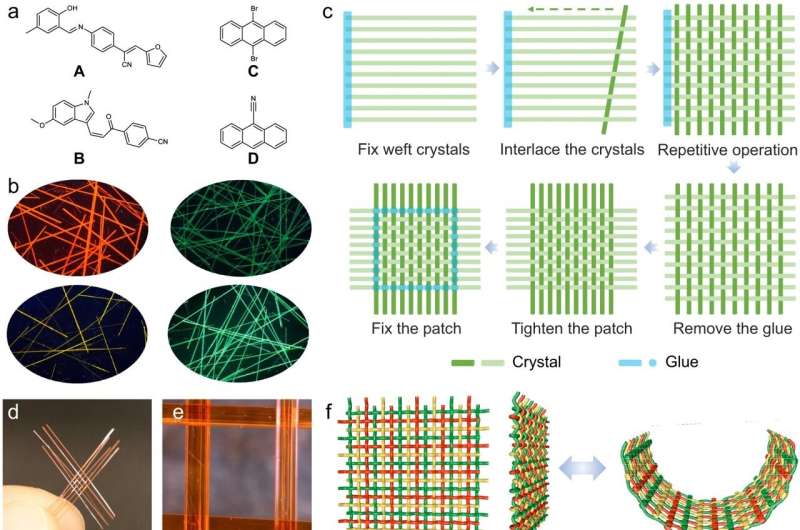This article has been reviewed according to Science X's editorial process and policies. Editors have highlighted the following attributes while ensuring the content's credibility:
fact-checked
peer-reviewed publication
trusted source
proofread
Researchers develop first-of-its-kind woven material made entirely from flexible organic crystals

Applying simple, ancient weaving techniques to newly recognized properties of organic crystals, researchers with the Smart Materials Lab (SML) and the Center for Smart Engineering Materials (CSEM) at NYU Abu Dhabi (NYUAD) have, for the first time, developed a unique form of woven "textile." These new fabric patches expand one-dimensional crystals into flexible, integrated, two-dimensional planar structures that are incredibly strong—some 20 times stronger than the original crystals—and resistant to low temperatures.
These traits give them a host of exciting potential applications, including in flexible electronics that range from sensing devices to optical arrays, as well as in extreme conditions such as low temperatures encountered in space exploration.
In the paper titled "Woven Organic Crystals" published in the journal Nature Communications, Panče Naumov, NYUAD Professor of Chemistry and Director of the CSEM, and colleagues from Jilin University demonstrate that organic crystal can be simply woven into flexible and robust patches with plain, twill, and satin textures.
Because the organic crystals are inherently flexible materials, the researchers found that the patches are not only light in weight but also robust to mechanical impact. They are more than 15 times more resilient to failure than the individual crystals, reflecting the enhanced collective action in response to bending or other impacts on these entangled structural elements.
The researchers also report that the thermal stability of the new "crystalline fabric" is another impressive asset of the flexible crystals. While the thermal stability depends on the actual crystals used in the weaving, crystalline patches of some of these crystals, remain flexible over a temperature range of about 350 oC, between –196 oC and 150 oC, which is superior to many polymers or elastomers that normally become brittle below their glass transition temperature.
The new fabric remains optically transmissive, providing the opportunity to construct networks of optical waveguides that can perform logic operations by selective laser excitation of the component crystals. The researchers report optical arrays of woven crystals that can perform simple logic functions to demonstrate that characteristic.
When organic crystals have the appropriate aspect ratio, they can be exceedingly mechanically compliant and either bent, curled, or twisted. This counter-intuitive flexibility of organic crystals is likely rooted in their weak intermolecular interactions which can sustain large stress without fracture.
"For thousands of years, weaving has been used to produce a range of textiles that are flexible, yet stronger than their component materials, resistant to abrasion and wear, and remarkably durable," said Dr. Naumov.
"Until recently, organic crystals were considered to be stiff and brittle; however, the realization that they can have extraordinary elastic properties has changed that paradigm, not only adding a new facet to their unique set of properties but also revealing an unexplored new direction in materials science. Our new concept of using crystals as the basis for a woven fabric opens up an exciting range of opportunities to combine these woven crystals with other materials for an untold number of technological applications."
More information: Linfeng Lan et al, Woven organic crystals, Nature Communications (2023). DOI: 10.1038/s41467-023-43084-7
Journal information: Nature Communications
Provided by New York University





















